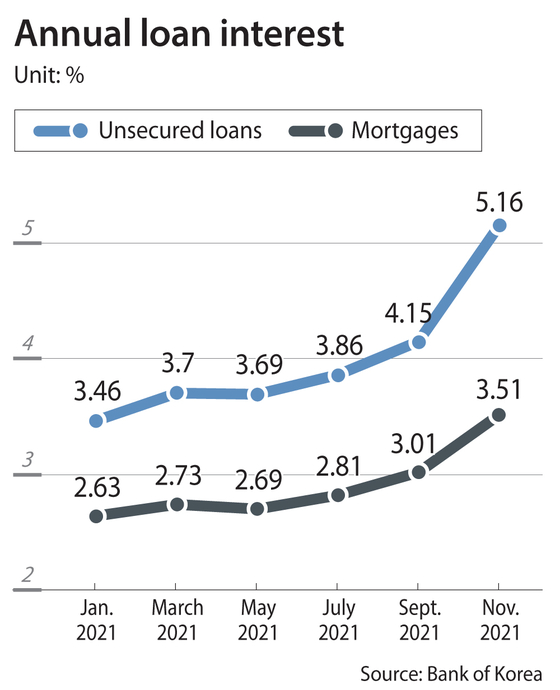Loan interest rates hit record levels

Loan interest rates are skyrocketing, hitting record levels as restrictions continue to limit the amount of lending.
The average annual interest of new unsecured loans in November was 5.16 percent according to the Bank of Korea (BOK), up 0.54 percentage points on month. The figure is the highest since 5.29 percent in September 2014 and the first time it surpassed 5 percent since October 2014.
Mortgage interest also soared, rising 0.25 percentage points on month to 3.51 percent. The interest is the highest since July 2014’s 3.54 percent.
Interest on new household loans was 3.61 percent on average, up 0.15 percentage points on month and the highest since December 2018.
“Household loan interest has been on the rise due to the increase of the benchmark interest rate, and is also influenced by banks increasing their interest spread to tame household debt,” said Song Jae-chang, head of the BOK’s financial statistics team.
“People with high credit are limited to borrow only within their annual income, and the average interest of unsecured loans rose as more was lent to people with mid to low credit levels.”
The Financial Supervisory Service in August requested banks to limit the upper cap for unsecured loans to match borrowers’ annual income, and many banks have been following the move.
People received an average of 1.57 percent interest for overall new deposits, up 0.28 percentage points on month. New time deposits had interest of 1.51 percent, up 0.23 percentage points, which is the highest since January last year.
Banks have been raising deposit and savings interests by a higher, or similar margin to the key rate increase as many criticized that banks were hiking loan interests too much, but not much on deposits. The key rate rose 0.25 percentage points to 1 percent in November.
There was a 1.66 percentage point difference between new deposit interest and loan interest, narrowing the difference by 0.12 percentage points on month.
Although loan interests have been on the rise, many chose to borrow under a floating interest rate that changes periodically based on the economic situation.
Of the total household loans in November, 82.3 percent chose to borrow with a floating interest rate, up 3 percentage points on month.
“There has been a decrease in mortgage loans, which make up for a big portion of loans with fixed interest, and the amount of people borrowing with fixed interest has been decreasing,” said the BOK's Song.
BY AHN HYO-SUNG, LEE TAE-HEE [lee.taehee2@joongang.co.kr]










with the Korea JoongAng Daily
To write comments, please log in to one of the accounts.
Standards Board Policy (0/250자)